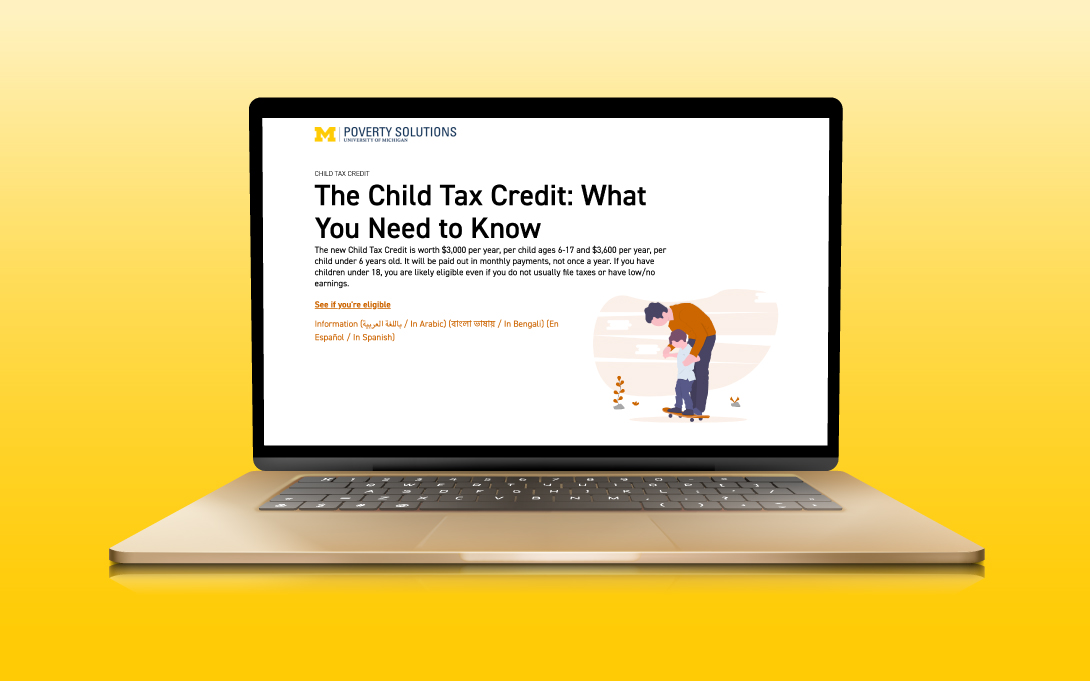
A new website from Poverty Solutions at the University of Michigan offers step-by-step guidance for parents to ensure they receive the expanded Child Tax Credit, which is worth up to $3,600 per child, per year.
The American Rescue Plan Act of 2021 increased the Child Tax Credit to $3,600 per year for children under 6 years old and $3,000 per year for children 6-17 years old. That means a single parent with a 4-year-old and 7-year-old would receive $6,600. The tax credit does not count as additional income that could affect eligibility for public assistance. The expanded Child Tax Credit will be paid out in regular payments rather than once a year, with monthly payments from the IRS of $250-$300 per child expected to start in July.
The first step to receive the tax credit is to file taxes for 2020, and the tax filing deadline is extended to May 17 this year. Parents of children under 18 may be eligible to receive this money, even if they have not previously filed taxes and have low or no earnings. Visit the Child Tax Credit: What You Need to Know website to learn more about eligibility for the expanded tax credit and see answers to frequently asked questions.
A recent survey of more than 10,000 households with low incomes, fielded by Propel in partnership with Poverty Solutions, shows the need for user-focused information on how to access the expanded Child Tax Credit. Propel runs a smartphone application used by people who receive food assistance, and less than half of those surveyed know about the Child Tax Credit and feel like they understand it. Families who are aware of it and understand it call it life changing.
“The expanded Child Tax Credit provides significant support for families and promises to lift millions of children out of poverty. The Child Tax Credit: What You Need to Know website aims to provide clear information that parents and service providers can use to make sure families receive this money,” said Afton Branche-Wilson, assistant director of community initiatives at Poverty Solutions at U-M.
This new model for the Child Tax Credit moves the U.S. closer to a universal child allowance, similar to what is offered in the United Kingdom and Canada. A universal child allowance provides monthly cash support to all families with children, whereas the Child Tax Credit previously used in the U.S. was paid in an annual lump sum and families with no earnings were not eligible.
“Raising kids is expensive. We know that many families face challenges covering the costs of rent, utilities, child care and food on a monthly basis, and the flexibility that a child benefit like this provides can enable them to use the money in the ways they view as most important in raising their families,” said H. Luke Shaefer, Poverty Solutions faculty director who is the Hermann and Amalie Kohn Professor of Social Justice and Social Policy and associate dean for research and policy engagement at U-M’s Gerald R. Ford School of Public Policy.
Shaefer is among a group of poverty scholars who have contributed significant research on the potential for an expanded child tax credit that follows the design of a child allowance to reduce child poverty rates in the U.S. Recent estimates from Columbia University’s poverty center find that this expanded Child Tax Credit will reduce child poverty by 45% overall, by 52% among Black children, by 62% among Native American children, and effectively eliminate the most extreme forms of child poverty, such as Shaefer wrote about in his book co-authored with Kathryn Edin, “$2.00 a Day: Living on Almost Nothing in America.”
“The American Rescue Plan is the boldest vision for fighting child poverty in the U.S. in at least 50 years,” Shaefer said. “Research shows if we can intervene while kids are young, it’s going to pay dividends in terms of higher academic performance, lower engagement with the criminal justice system, and higher earnings over a lifetime.”
However, this expansion of the Child Tax Credit is temporary; the American Rescue Plan puts it in effect for one year. Shaefer said it is important to document and analyze how the expanded Child Tax Credit affects families’ experience of material hardship in the coming year in order to inform debates about permanently offering the benefit.
“A permanent child allowance would provide a base level of support for middle-class and low-income families to rely on, and it would create a stronger safety net for our country,” Shaefer said. “We are better off as a society if we invest in our kids.”
More information
- Child Tax Credit: What You Need to Know factsheet (also in Arabic, Bengali and Spanish)
- Listening to SNAP Participants to Improve Access to Expanded Child Tax Credit (policy brief)
- Coronavirus Stimulus Payments website
- Michigan COVID-19 Pandemic Resource Guide
- Trends in Hardship and Mental Health in the United States at the end of 2020 (policy brief)
Originally written and published by Lauren Slagter at Poverty Solutions.
